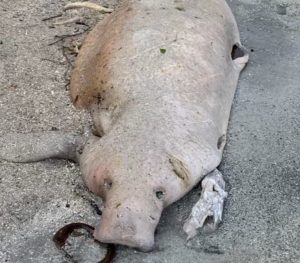(By Kim Ryan) According to FWC preliminary manatee mortality statistics (as of 12/24/21), Florida lost a staggering number of manatees in 2021 with the number sitting at 1,083.
That number far exceeds the 5 year average of 612. By far the county suffering the greatest loss was Brevard with 353 manatee deaths. Lee County was second with 109 deaths
There have been many reports this year debating why the deaths are occurring and what can be done about it.
Many of the deaths occurred in the Indian River Lagoon on the East coast of Florida. What’s to blame? A combination of things contribute to manatee deaths, including; habitat loss, cold stress and boat strikes. However, marine experts say this year starvation caused by pollution-fueled loss of sea grasses (a major food source) have culminated in a large-scale, ongoing manatee die-off in 2021.
That led the National Oceanic and Atmospheric Administration (NOAA) to declare an Unusual Mortality Event (UME) along Florida’s Atlantic coast from the Indian River Lagoon to the Keys.
According to a statement issued by the Center for Biological Diversity, a non profit organization that works toward protecting endangered species, “Over half of the more than 1,000 manatee deaths in Florida this year were attributable to starvation. The mass die-off was caused by pollution-fueled algae blooms that killed thousands of acres of seagrass in the Indian River Lagoon.”
What can be done?
In December, The U.S. Fish and Wildlife Service and Florida Fish and Wildlife Conservation Commission approved a joint plan to begin supplementing the diet of malnourished manatees in the Indian River Lagoon. This was an effort to keep the manatees from starving due to the devastating loss of seagrass beds in that area.
According to Save the Manatee Club, manatees can eat 10 – 15% of their body weight in vegetation daily. A 1,000-pound manatee, for example, would probably eat between 100 – 150 pounds of food a day.
In addition to the supplemental feeding trial, the FWC and USFWS are assisting partners with a variety of other efforts to help reduce manatee mortality, specifically along the East Coast of Florida. Both agencies have increased law enforcement presence along the waterways in the areas most affected by the UME. Officers will watch for manatees in need of assistance and help ensure existing speed zones are followed. The speed zones help reduce the likelihood of manatees being struck by boats.
The loss of these gentle giants has propelled the Center for Biodiversity and others to join in issuing a notice of intent to sue the Environmental Protection Agency.
“It’s disgraceful that hundreds of manatees have died as a direct result of regulators’ failure to protect our water quality,” said Jaclyn Lopez, Florida director at the Center.
“Until Florida is forced to rein in its rampant pollution, manatees will continue to die slow, agonizing deaths by starvation every winter,” said Lindsay Dubin, staff attorney at Defenders of Wildlife. “The EPA must act immediately to improve water-quality standards lest it further jeopardize the future of this iconic species.”
Manatees once classified as “endangered” under the Endangered Species Act in 1967 had their status changed in 2017 as the U.S. Fish and Wildlife Service downgraded them to “threatened”species defined as likely to become endangered in the foreseeable future.
Let’s hope 2022 brings all stakeholders together to effect a significant reduction in all the threats now faced by the manatees and that a resurgence in the sea cow population can be celebrated at this time next year.

